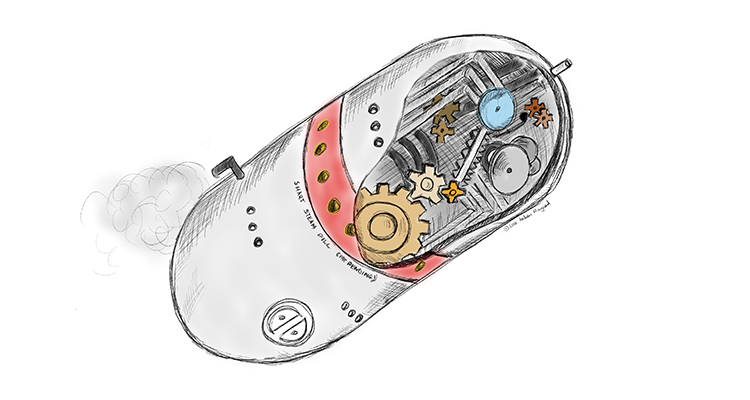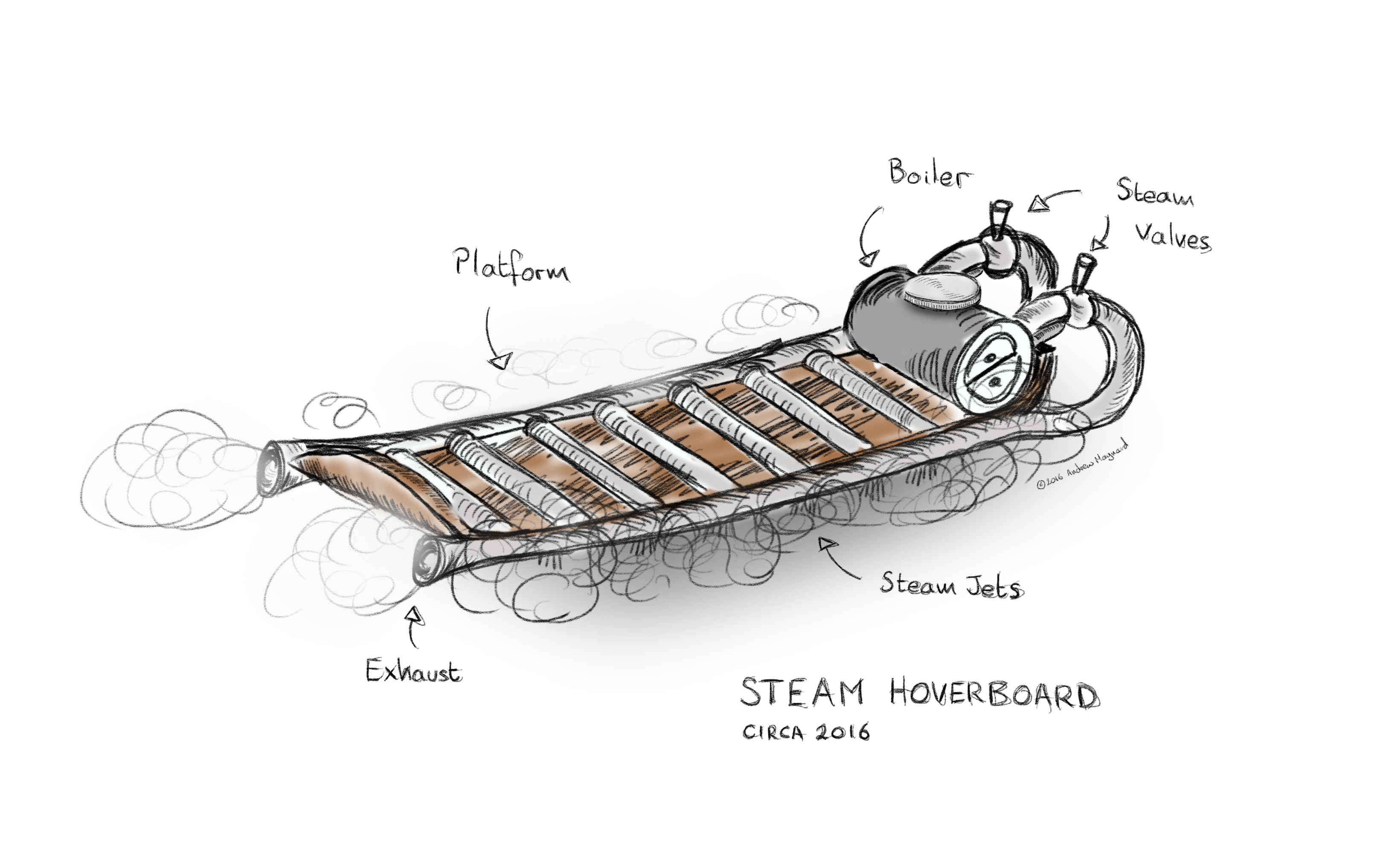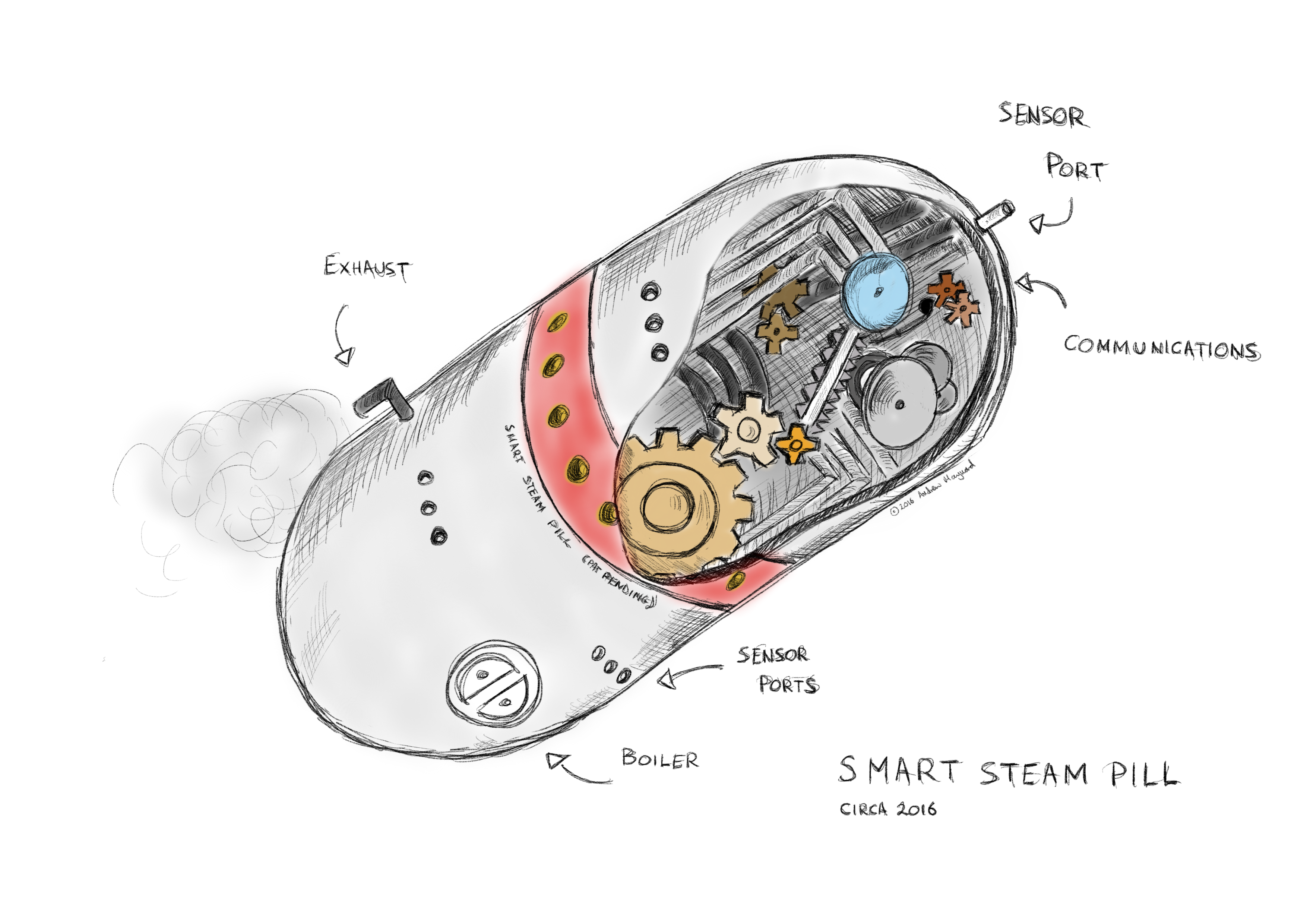It’s that time of year again when technology pundits peer into their crystal balls, and predict the hottest tech trends of the coming twelve months.
If you’re a consumer of such lists, you’ll already know that 2016 could be the breakthrough year for blockchain (despite no-one being quite sure what it is), and that virtual reality is poised – once again – to become the Next Big Thing.
Let’s be honest though, these lists can get a little stale.
So I thought I’d break ranks this year by imagining what a top tech trends list would look like in a “steampunk” world, where steam engines, clockwork mechanisms, and retro-artistic flair, rule supreme.
Here, then, is the fully authoritative and completely reliable “Steampunk technology Trends to Watch for in 2016”
Steam Hoverboards
Hot on the heels of their battery-powered cousins, steam-powered hoverboards are poised to take consumers by storm this year. Users are levitated on a platform supported by thousands of downward-thrusting steam jets, while balance is ensured by the addition of coupled mechanical gyros.
These “true” wheel-less hoverboards allow riders to effortlessly glide above the ground. They’re powered by a miniature coal-fired boiler worn on the back, although for the environmentally conscious hoverboarder, wood-fired units are also available.
Admittedly, there have been recent reports of exploding steam hoverboards. However, as regulators struggle to wrap their heads around such a novel emerging technology, manufacturers are claiming that the boards are no more dangerous than any other wearable tech using high-pressure boilers and super-heated steam. According to the leading retailer “when used safely, steam hoverboards are a low risk way to get around”
Steam-Powered Augmented Reality
In 2016, we can expect to see the first steam-powered augmented reality systems hit the consumer market. These will most likely rely on two breakthrough technologies: clockwork-synchronized stereo imagery, and steam-powered haptic feedback.
For millennia, story-tellers have used shadow-figures to create compelling narratives. Clockwork-synchronized stereo imagery brings this ancient technology into the twenty first century by projecting stereo-pair shadows onto a users’ view.
By mechanically synching shadows with user head movements, developers are creating immersive gaming environments that merge fantasy and reality.
Steam-powered haptic feedback systems use gloves embedded with hundreds of controllable fine steam nozzles. These are able to recreate a realistic sensation of touch, whether stroking a rabbit, or stoking a boiler.
When combined with clockwork-synchronized stereo imagery, these haptic feedback systems create a truly immersive experience.
Critics of steam technologies worry that users will become so immersed in these augmented reality systems that they become disconcertingly disconnected from real life. Some go as far as to claim that this is already occurring with wealthy early-adopters.
Smart Steam Pills
2016 is predicted to be the year when “internables” come into their own. Hot on the heels of body-mounted “wearables”, internables are tech that you put inside your body, to track your health.
Technologists have been struggling for years to make steam-powered devices small enough and safe enough to be placed inside the human body. But over the next twelve months, expect major breakthroughs in steam internables.
Fist to market is likely to be the smart steam pill. Designed to be ingested, this steam-powered mechanical pill monitors your gastrointestinal health. Regular updates from your gut are provided by a series of chimes – one for “all is good”, two for “possible trouble”, and three for “medical advice advised”.
While the first generation of smart steam pills are designed to be recoverable, experts are predicting disposable versions within the next one to two years.
The side-effects of the smart pill are considered to be marginal by developers, but they do warn that users can expect some “gassiness” from the integrated steam engine. However, enterprising developers are already working on how they might use this as yet another way to provide real-time feedback.
While manufacturers are confident in the technology, the U.S. Food and Drug Administration (FDA) remains uncertain on when smart steam pills will be granted regulatory approval. According to the agency, the technology is so novel that steam-powered drugs and devices are being considered on a case-by-case basis.
Steam-Powered Artificial Intelligence
Consumers can expect steam-powered artificial intelligence (AI) to get a boost in 2016. Miniaturization of mechanical automata is now at the point where millions of artificial clockwork “neurons” can be connected together, to produce thinking-machines. And while full-blown steam-driven artificial intelligence is still some distance away, practical steam-AI applications are nearing commercial viability.
Simple natural language processing machines are likely to be at the vanguard of the steam-AI revolution. Early devices can already understand and act on short sentences, as long as they are delivered as a series off clicks, whirrs and whistles. And researchers are actively working on translation automata that can bridge the AI-human language gap.
While proponents of steam-AI are optimistic about the technology’s potential, there are concerns that it could spiral out of control if not developed responsibly.
For instance, there’s the classic “paper clip apocalypse” scenario, where a series of clicks and whistles is inadvertently interpreted as an instruction to maximize production of paper clips. In it’s most dramatic projections, this scenario ends up with everything being converted to paper clips, and the end of life as we know it.
Steam-AI critics have also raised the possibility of a steam “superintelligence” arising, that threatens humanity’s very existence. To avoid this, developers are already working on steam-AI systems with enough human foibles hard-wired in to ensure that they are as corruptible and manipulate-able as their inventors.
Internet of Steam Things
The number of steam-powered gadgets that can remotely communicate through audible clicks and whistles, has grown exponentially in recent years, to the point that a interconnected network – an Internet of Steam Things (IoST) – is believed to be just over the horizon.
This will be a boon for users who want to remotely control their home boiler, run remote diagnostics on their steam-carriage, or give their doctor real-time access to their internables.
The IoST is also poised to revolutionize manufacturing, as tools and devices along the production chain begin to “talk” to each other.
However, there are growing security worries, as steam-hackers learn to manipulate and control IoST devices with well-crafted streams of clicks, whirrs and whistles. Regulators are already looking at limiting public whistling and finger snapping as a step toward closing potential IoST security loopholes.
Reality Check
Sadly, none of these technologies will be hitting the streets in 2016. Instead, we’re stuck with their non-steam counterparts – hoverboards, augmented (and virtual) reality, internables (yes, they’re real), artificial intelligence, and the Internet of Things.
These – and many other less well-known but equally influential technologies – will undoubtedly make their mark in 2016. But without thinking through future consequences, these “marks” may not always be for the greater good.
Imagining a steampunk tech future may be a bit of fun. But it also emphasizes the need to think about the downsides of technology innovation as well as the benefits – something that’s starkly absent in many of this years tech trends lists.
Maybe, with a bit of creativity, next year will be different.



